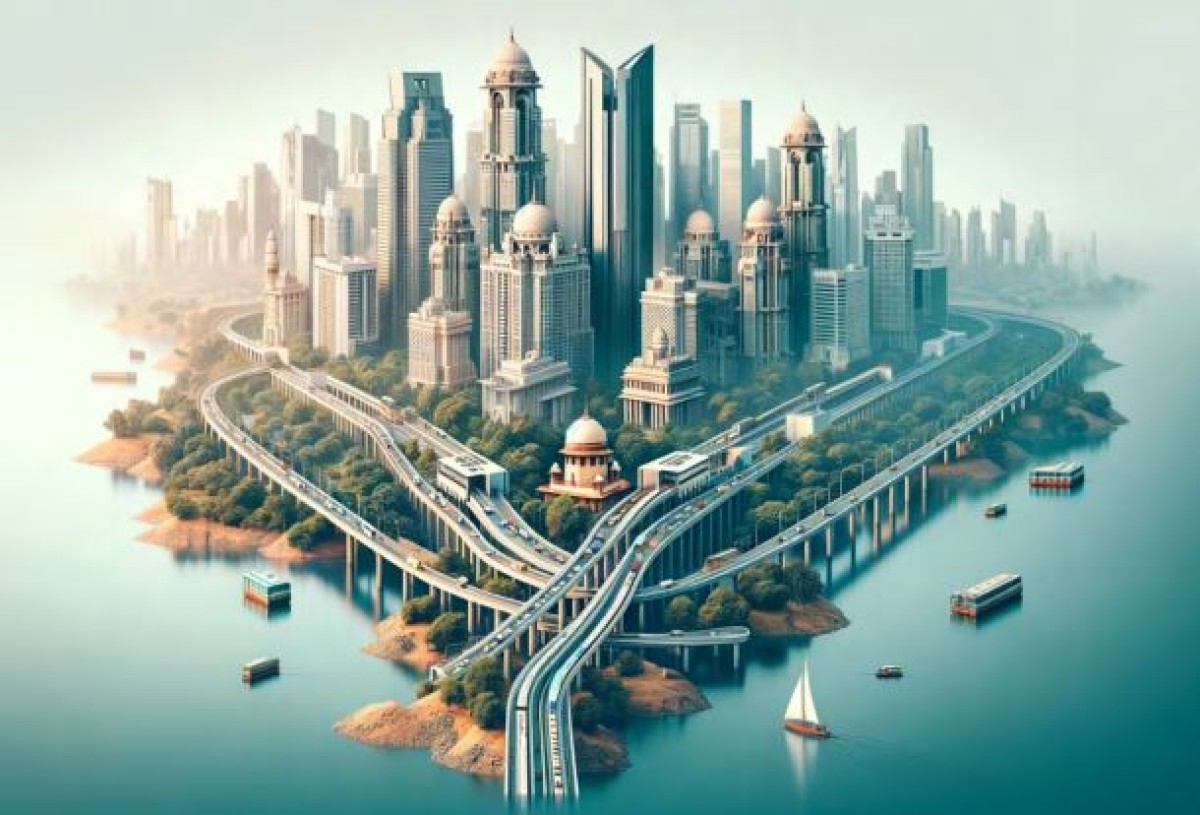How the Indian Infrastructure Sector Unleashing its Potential!
Infrastructure is a key enabler in helping India become a US $26 trillion economy.
• India has to enhance its infrastructure to reach its 2025 economic growth target of US$ 5 trillion.
• India’s population growth and economic development require improved transport infrastructure, including investments in roads, railways, and aviation, shipping and inland waterways.
• As per the Reserve Bank of India (RBI) in the past 4 years until March 2024, Real Estate Investment Trusts (REITs) and Infrastructure Investment Trusts (InvITs) have amassed US$ 15.60 billion (Rs. 1.3 lakh crore).
• According to a Cushman & Wakefield report, India’s real estate market saw a surge in investments during the second quarter of 2024, attracting US$ 2.77 billion.
• Under Interim Budget 2024-25, capital investment outlay for infrastructure has been increased by 11.1% to Rs.11.11 lakh crore (US$ 133.86 billion), which would be 3.4 % of GDP.
Key Highlights:-
• As per the data availed by the Department of Economic Affairs, the country needs to invest USD 4.5 trillion for the development of the infrastructure sector before 2030 to ensure its perpetual growth at a fast pace and achieve its goal of becoming a USD 5 trillion economy by 2025!
• The India Infrastructure Sector Market size is estimated at USD 204.06 billion in 2024, and is expected to reach USD 322.27 billion by 2029, growing at a CAGR of 9.57% during the forecast period (2024-2029).
• India’s aspirations to attain developed nation status by 2047 heavily rely on bolstering its infrastructure, a pivotal driver for creating livable, climate-resilient, and inclusive cities that fuel economic growth. This commitment is evident in the government’s allocation of 3.3% of GDP to the infrastructure sector in FY2024, with a notable emphasis on transport and logistics.
• Within the transport sector, roads and highways claim the lion’s share, trailed by railways and urban public transport. The government has set ambitious goals, aiming to construct a 2 lakh-km national highway network by 2025, expand airports to 220, operationalize 23 waterways by 2030, and establish 35 Multi-Modal Logistics Parks (MMLPs).
• Infrastructure is the backbone of domestic and international commerce and industrial and agricultural production. It is the fundamental organizational and physical framework necessary to operate a firm successfully. The infrastructure sector focuses on major infrastructure sectors such as power, roads and bridges, dams, and urban infrastructure.
• Infrastructure is a key enabler in helping India become a US $26 trillion economy. Investments in building and upgrading physical infrastructure, especially in synergy with the ease of doing business initiatives, remain pivotal to increase efficiency and costs. Prime Minister Mr. Narendra Modi also recently reiterated that infrastructure is a crucial pillar to ensure good governance across sectors.
• The government’s focus on building infrastructure of the future has been evident given the slew of initiatives launched recently. The US$ 1.3 trillion national master plan for infrastructure, Gati Shakti, has been a forerunner to bring about systemic and effective reforms in the sector, and has already shown a significant headway.
• Infrastructure support to the nation’s manufacturers also remains one of the top agendas as it will significantly transform goods and exports movement making freight delivery effective and economical.
• The “Smart Cities Mission” and “Housing for All” programmes have benefited from these initiatives. Saudi Arabia seeks to spend up to US$ 100 billion in India in energy, petrochemicals, refinery, infrastructure, agriculture, minerals, and mining.
• The infrastructure sector is a key driver of the Indian economy. The sector is highly responsible for propelling India’s overall development and enjoys intense focus from the Government for initiating policies that would ensure the time-bound creation of world-class infrastructure in the country. The infrastructure sector includes power, bridges, dams, roads, and urban infrastructure development. In other words, the infrastructure sector acts as a catalyst for India’s economic growth as it drives the growth of the allied sectors like townships, housing, built-up infrastructure, and construction development projects.
• To meet India’s aim of reaching a US$ 5 trillion economy by 2025, infrastructure development is the need of the hour. The government has launched the National Infrastructure Pipeline (NIP) combined with other initiatives such as ‘Make in India’ and the productionlinked incentives (PLI) scheme to augment the growth of the infrastructure sector. Historically, more than 80% of the country’s infrastructure spending has gone toward funding for transportation, electricity, and water, and irrigation. Infrastructure development has been one of the key factors for driving the overall growth of India, along with the aim of becoming a USD five trillion economy by 2025. India’s journey towards becoming a developed nation by 2047 hinges significantly on improving its infrastructure, a cornerstone for fostering liveable, climate-resilient, and inclusive cities that drive economic growth. The government’s commitment is evident through its allocation of 3.3% of GDP to the infrastructure sector in the fiscal year 2024, with particular focus on the transport and logistics segments. As per the data availed by the Department of Economic Affairs, Government of India (GoI), the country needs to invest USD 4.5 trillion for the development of the infrastructure sector before 2030 to ensure its perpetual growth at a fast pace and achieve its goal of becoming a USD 5 trillion economy by 2025. The infrastructure sector consists of the development of power plants, dams, bridges, highways (national and regional), railways and urban infrastructure development. Besides these, the sector also deals with the upgradation of old infrastructure projects. To uplift the infrastructure sector, GoI has developed the National Infrastructure Pipeline (NIP) to attract investments and project preparation along with other initiatives like ‘Make In India’ and Gati Shakti, among others. India is one of the fastest-growing economies in the world and has witnessed tremendous growth in its infrastructure sector. The government of India has identified infrastructure as one of the key drivers for economic development and has taken several steps to boost investments in the sector. This has led to a surge in governmentbacked infrastructure projects that are aimed at modernizing India’s infrastructure and improving the quality of life for its citizens. India’s infrastructure sector has been witnessing a surge in investments over the past few years. The government of India has been introducing many initiatives to promote investment in the sector, such as Make in India, Smart Cities and Infrastructure Development Finance Corporation (IDFC). These initiatives have helped to increase investment in various segments of infrastructure such as roads, railways, energy, water and sanitation. The development of infrastructure is important as it provides numerous economic, social and environmental benefits. It helps to increase GDP growth, create job opportunities, improve trade and investment opportunities, provide better connectivity and accessibility, improve healthcare facilities, and reduce pollution levels. Roads & Highways account for the highest share, followed by Railways and Urban Public Transport. The government has set ambitious targets for the transport sector, including development of a 2 lakh-km national highway network by 2025 and expanding airports to 220. Additionally, plans include operationalizing 23 waterways by 2030 and developing 35 Multi-Modal Logistics Parks (MMLPs). The total budgetary outlay for infrastructure-related ministries increased from around INR 3.7 Lakh Cr in FY23 to INR 5 Lakh Cr in FY24, offering investment prospects for the private sector across various transport subsegments. As the transport sector gears up to address sustainability challenges, the private sector stands poised to capitalize on the conducive policy environment to accelerate infrastructure investments. Public-Private Partnerships (PPPs) have served as a vital mechanism for private sector engagement across various infrastructure domains, notably in the construction of airports, ports, highways, and logistics parks throughout India. Besides support from the central government and states across various schemes, India needs a significant push from Public-Private Partnerships to achieve its goal of reaching a $5 Trillion economy by 2025.
Infrastructure’s role in the Indian economy
There is no doubt that infrastructure growth is critical for a country’s development. To promote such growth, India is leading efforts to dedicate attention and funds to developing infrastructure, which is evident by the efforts at the central and state levels. The pandemic and the subsequent challenges to the supply chain led to India’s focus on “Make in India” and self-reliance. In light of the disruptions within the logistics sector, India resolved to expand and modernize its manufacturing capabilities. This shift in focus fueled the country’s goal to focus on infrastructure development. The governments on central and state levels are bringing in policies to facilitate the planning and execution of projects relating to power, roads and infrastructure needed for urban development, such as public transport and e-vehicles. In this article, we attempt to chart India’s path for building infrastructure
Infrastructure is currently a key focus for India
One of the major initiatives, Gati Shakti, led to a shift within the infrastructure sector. Also known as the National Master Plan for Multi-modal Connectivity, the project is worth US$1.2t and aims to streamline the planning process and ensure that resources are effectively directed towards development planning. The different divisions of the governments will now have a platform to work together on infrastructure projects such as roads, railways, airports, ports, mass transport and waterways. To further augment infrastructure development, the Indian government introduced the National Infrastructure Pipeline (NIP). The pipeline involves an estimated funding of more than US$1t over five years and includes projects in the renewable energy sector expected to actively involve private participants. India also made headway in its plans for infrastructure development through a sovereign wealth fund. The fund is the National Investment and Infrastructure Fund (NIIF). NIIF was set up to manage investments and is intended to serve as a platform for co-investment by global and domestic investors and multilateral development banks (MDBs). The fund’s primary focus is on infrastructure and growth equity. In October 2023, the government announced the launch of an IndiaJapan Fund through a partnership with the Japan Bank for International Cooperation (JBIC). The fund has sanctioned US$600m and is dedicated to investments in efforts promoting sustainability and low carbon emissions. Further fostering the India-Japan strategic partnership, on February 20, 2024, the Japan International Cooperation Agency (JICA) announced that it has signed loan agreements for up to ¥232,209m. These loans are dedicated to funding certain projects, which include road network connectivity projects, a freight corridor project and projects for climate change response and enhancement of ecosystem services in specific areas within India. The recent shift in India’s focus on the infrastructure sector has led to the launch of several highscale projects across the country. The highway connecting the capital city, Delhi, with the financial city, Mumbai, is one of them. This unprecedented project is expected to be completed this year and significantly reduce travel time between the two megacities. With the project’s first phase already inaugurated this month, India continues its push to enhance infrastructure. 2024 will also be marked by the completion of the world’s highest railway bridge. Launched on February 20 of this year, this bridge is predicted to promote supply chain and economic growth significantly. The completion of this project is seen as evidence of India’s capabilities in civil engineering. More than a dozen other highway projects are in progress. Plans to develop and modernize railway corridors are also underway. With the launch of the UDAN scheme, the country’s aviation sector is also expected to boom. The scheme has led to a doubling of the number of airports. The culmination of these projects is expected to strengthen the country’s supply-chain sector significantly. The government is aiming to strike a balance between urban transformation and schemes promoting responsible commuting. The “PM-eBus Sewa Scheme” launched last year is one of such schemes. This initiative will re-invent the country’s bus operations and encourage the use of public transport through payment security mechanisms.
The government’s efforts to complement urban development with sustainability
The interim budget allocation announced for 2024/25 earlier this month signals India’s continued commitment to build infrastructure. The Indian government will devote about US$134bn to projects within the infrastructure sector. This step will raise the country’s spending in the sector by around 11 percent compared to last year. In 2021, the government launched the PM Gatishakti National Master Plan (NMP) with a focus on major transport sectors to enhance multimodal connectivity infrastructure in various economic zones. It aims to bring together the infrastructure schemes such as Bharatmala, Sagarmala, UDAN etc. under a digital platform. The NMP offers a detailed database of trunk and utility infrastructure, ongoing and future projects from different ministries/departments of both the Central Government and States/UTs. Integrated with the GIS-enabled PM Gatishakti platform, this allows for streamlined planning, design, and monitoring of next-generation infrastructure projects on a single portal. As per the India Investment Grid (IIG) database, there are currently 15,580 projects worth $2388.93 Bn at various stages of development. Alongside this, the National Logistics Policy, addresses the development of integrated infrastructure and efficiency in services, including processes and regulatory frameworks, through its Comprehensive Logistics Action Plan (CLAP). Together, the NMP and the National Logistics Policy provide a framework for creating a datadriven decision support mechanism to enhance logistics efficiency and reduce costs in the country’s logistics ecosystem.
Major plans of Indian Infrastructure:
Roads: The Bharatmala Pariyojana is progressing with Phase I focusing on developing 34,800 km of National Highways. It emphasizes corridorbased development and is set to conclude by 2027-2028, covering 31 States/UTs and over 550 districts. Additionally, the government targets building 22 new greenfield expressways, signaling significant advancements in India’s transportation infrastructure.
Airports: The Ministry of Civil Aviation’s flagship Regional Connectivity Scheme UDAN (Ude Desh Ka Aam Nagarik) aims to enhance air connectivity to regional airports in small towns. Launched in 2016, UDAN focuses on making flight services accessible to common citizens by developing infrastructure and air connectivity. In its first 5 years, UDAN served over one crore passengers, inaugurating 425 new routes and 58 airports. The Budget for 2023–24 allocated INR 1,244.07 Cr to UDAN, doubling the previous year’s budget, with plans to revive 22 airports. Additionally, the government outlined the revival of 50 additional airports, heliports, water aerodromes, and advanced landing grounds.
Railways: India’s railway sector is undertaking ambitious projects such as the MumbaiAhmedabad Speed Rail Corridor, the world’s highest pier bridge under construction, and the Chenab bridge in Jammu & Kashmir - the world’s highest railway bridge. With a total Broad Gauge network of 61,508 km electrified as of December 2023, the sector has also introduced 35 indigenously designed Vande Bharat Express trains, with six more set to launch soon. These trains serve up to 247 districts across the country. Indian Railways aims to become a Net Zero Carbon Emitter by 2030, with 211 MW of solar plants and 103 MW of wind power plants commissioned as of October 2023, along with 2150 MW of renewable capacity tied up.
Ports: Indian Ports “Turn Around Time” has reached 0.9 days which is better than USA (1.5 days), Australia (1.7 days) and Singapore (1.0 days), as per the World Bank’s Logistics Performance Index (LPI) Report 2023. Sagarmala, the flagship Central Sector Scheme of the Ministry of Ports, Shipping and Waterways, promotes port-led development in the country through harnessing India’s 7,500 km long coastline, 14,500 km of potentially navigable waterways and strategic location on key international maritime trade routes. The Union Minister for Ports, Shipping and Waterways said that the country’s total port capacity will increase from the existing 2,600 MTPA (Mn Tonnes per annum) to more than 10,000 MTPA in 2047. From April to November 2023, cargo of 86.47 MMT moved through Waterways as compared to 80.44 MMT during April to November 2022, i.e. an increase of 7.49%. The government also aims to operationalise 23 waterways by 2030. It is essential for India to prioritize the development of both urban and rural areas to ensure overall national progress. By 2030, it is projected that 40% of India’s population will reside in urban areas, contributing significantly to the country’s GDP. However, rapid urbanization poses challenges in managing infrastructure and delivering services effectively. The Smart Cities Mission is a key initiative aimed at addressing these challenges efficiently. As of February 2024, 6,753 projects out of a total of 7,991 have been completed under the Smart Cities Mission, showcasing tangible progress. Moreover, India has made significant strides in digital infrastructure development, with rural areas expected to contribute significantly to new internet user growth, with around 56% of total new internet users coming from rural India by 2025, according to a report by TransUnion CIBIL. This trend underscores the increasing connectivity between rural and urban regions in the country.
The government’s efforts to complement urban development with sustainability
The interim budget also unveiled the viability gap funding, which will be offered for offshore wind power projects. In addition, through the rooftop solar programme (PMSY Scheme), several households will benefit from free electricity and rooftop solar installations. Efforts in procuring biomass aggregation machinery will benefit from funding options. The budget also featured plans to develop infrastructure for manufacturing and charging e-vehicles. Along with the efforts to spur investments in infrastructure building, the country is bringing back the focus on sustainable development, especially in light of its commitment to attain zero greenhouse gas emissions by 2070.
Challenges facing building India; Making it happen
India is prioritizing infrastructure development, but there are certain hurdles that it must tackle. The recent initiatives introduced in India indicate a shift in the government’s approach to infrastructure development by inviting private investment within the infrastructure sector. With the growing interest of foreign investors, it is becoming crucial for India to ensure a conducive investment climate and maintain an effective regulatory regime to protect investors’ interests. Procedural delays and regulatory hurdles are posing the risk of driving foreign investment away. An adequate regulatory regime, transparent governance and an efficient and streamlined licensing process are needed to cover all stages of infrastructure projects.
Conclusion
The infrastructure sector plays a pivotal role in driving India’s economic growth and overall development. As the country continues on its path towards becoming a global economic powerhouse, the need for robust infrastructure becomes increasingly apparent. Private sector partnerships have emerged as crucial enablers in this endeavor, bringing in much-needed investment, innovation, and efficiency. By leveraging publicprivate partnerships (PPPs), India can accelerate infrastructure development while ensuring sustainability and inclusivity. These partnerships not only help bridge the financing gap but also foster competition, encourage technological advancements, and promote best practices in project execution. Ultimately, the collaboration between the government and the private sector is essential for creating resilient, future-ready infrastructure that paves the way for a prosperous and sustainable future for all citizens of India.
















Leave a comment